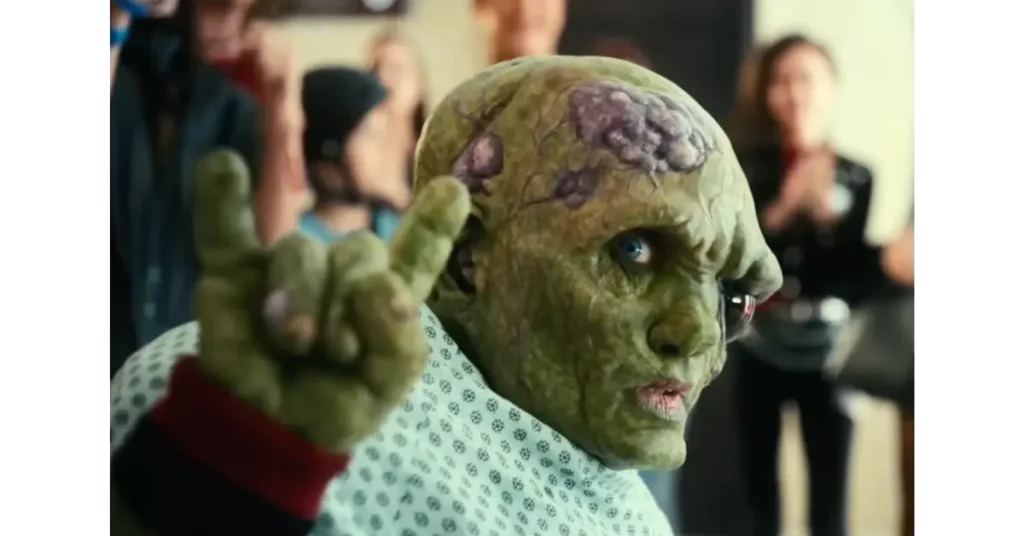After nearly two decades of development hell and distributor fears over its unrelenting gore, The Toxic Avenger (2025) has finally mutated its way onto theater screens, bringing Troma Entertainment’s most beloved mascot into the modern era. Director Macon Blair takes the reins from franchise creator Lloyd Kaufman, delivering a surprisingly expensive-looking reboot that honors the original’s splatter-punk spirit while crafting something genuinely fresh for contemporary audiences.
What makes this Macon Blair Toxic Avenger particularly compelling is how it balances reverence for the source material with bold creative choices that justify its existence beyond mere nostalgia cash-grab. Starring Peter Dinklage as the transformed janitor Winston Gooze and featuring a murderer’s row of talent including Kevin Bacon, Jacob Tremblay, and Elijah Wood, this radioactive superhero movie proves that cult classics can be successfully reimagined when placed in the right creative hands.
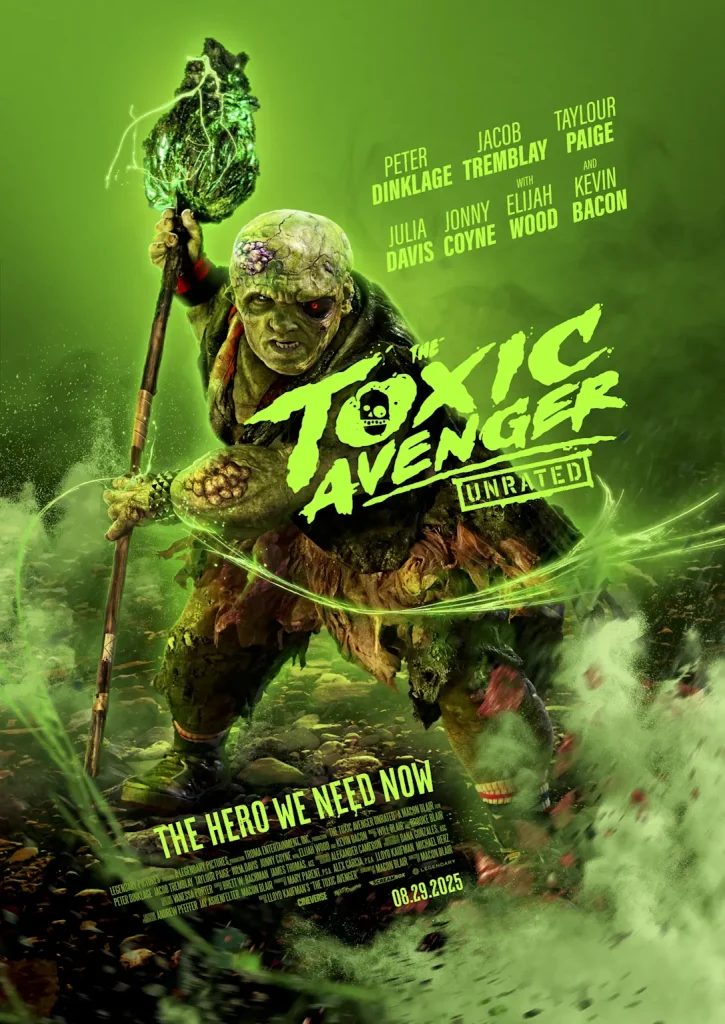
The Legacy of Toxie: From 1984 Cult Classic to Modern Reboot
Troma’s Underground Empire
To understand why The Toxic Avenger 2025 matters, you need to appreciate the twisted genius of the original franchise. The Toxic Avenger 1984 emerged from the demented minds of Lloyd Kaufman and Michael Herz at Troma Entertainment, a scrappy independent studio that specialized in turning tiny budgets into maximum mayhem. What started as a $475,000 B-movie about a bullied janitor transformed by toxic waste became one of the most enduring cult franchises in cinema history.
The Toxic Avenger movies spawned an entire universe that includes The Toxic Avenger Part II (1989), The Toxic Avenger Part 2 continuation, and the notorious Citizen Toxie: The Toxic Avenger IV (2000). The franchise even generated a Saturday morning cartoon called Toxic Crusaders, comic books, video games, and enough merchandise to stock a small toxic waste facility.
The genius of the original film The Toxic Avenger lay in its gleeful subversion of superhero tropes. While Marvel and DC heroes maintained moral perfection, Toxie the Toxic Avenger brutally dismembered criminals with his signature mop, all while maintaining an innocent, childlike demeanor. This combination of extreme violence and environmental messaging, wrapped in deliberately cheap production values, created something uniquely transgressive that resonated with audiences hungry for alternatives to mainstream entertainment.
Why Now? The Perfect Time for Toxic Revival
The timing for The Toxic Avenger reboot couldn’t be better. After years of sanitized superhero spectacle dominating multiplexes, audiences are craving something genuinely subversive and unpredictable. Macon Blair, whose previous film “I Don’t Feel at Home in This World Anymore” earned critical acclaim for its darkly comic take on vigilante justice, brings the perfect sensibility to update Troma’s anti-hero for modern audiences.
Blair’s approach respects what made the original special while addressing its limitations. Where Kaufman’s guerrilla filmmaking style often resulted in genuinely amateur moments that broke immersion, Blair crafts a more polished experience that maintains the anarchic spirit without sacrificing technical competence. The result feels like what the original might have been with a proper budget and experienced cast.
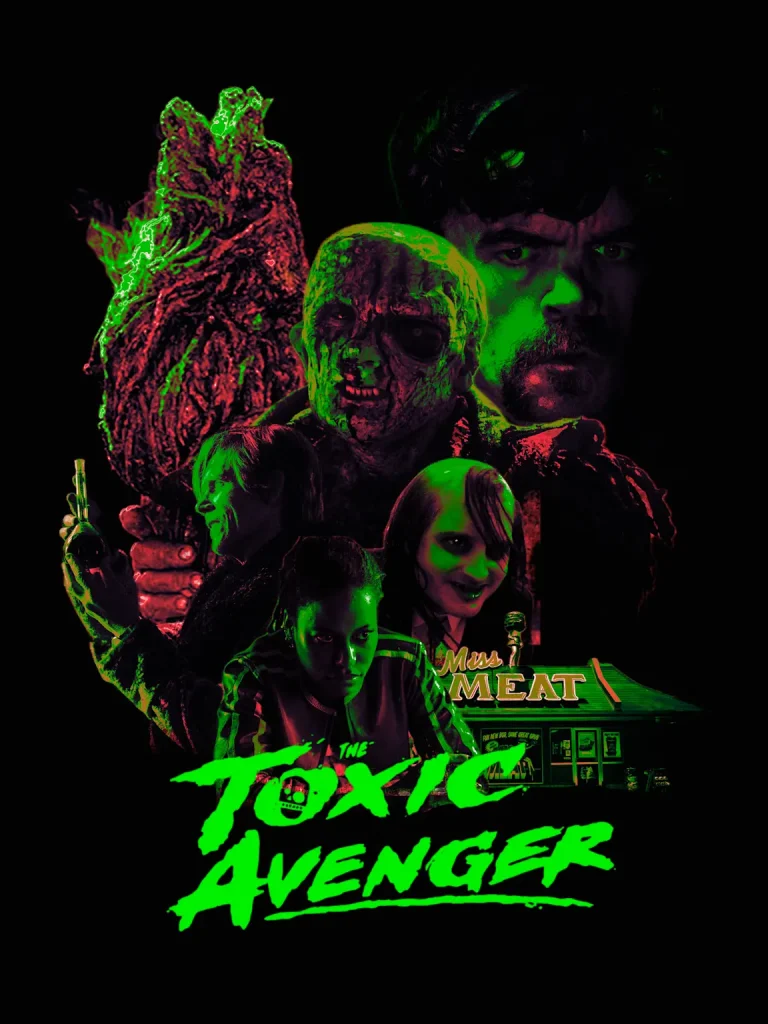
Winston Gooze: Peter Dinklage’s Radioactive Transformation
Casting Against Type
Peter Dinklage Toxic Avenger represents one of the year’s most inspired casting choices. Known for bringing dignity and complexity to roles that could easily become caricatures, Dinklage transforms the traditionally broad Toxic Avenger into something approaching genuine pathos. His Winston Gooze begins as a struggling single father facing terminal cancer, creating emotional stakes that ground the subsequent mayhem in recognizable human pain.
Unlike the original’s Melvin Ferd, who functioned more as a plot device than a character, Winston feels like a real person crushed by systemic indifference. Dinklage brings his considerable dramatic skills to bear on material that could have easily descended into pure camp, finding genuine emotion in the most absurd situations. When Winston discovers his cancer diagnosis, Dinklage’s performance carries real weight, making the audience genuinely invested in his transformation rather than simply waiting for the gore to begin.
The physical transformation itself represents a fascinating creative choice. Rather than putting Dinklage in the full Toxic Avenger suit, Blair employs Luisa Guerreiro as the suit performer while Dinklage provides voice work. This approach allows for more elaborate action sequences while preserving Dinklage’s vocal performance, which becomes increasingly important as Toxie develops throughout the film.
A Father’s Desperate Measures
The horror comedy 2025 movies landscape is crowded with films that mistake volume for humor, but Blair’s script understands that the best comedy comes from character-driven situations. Winston’s relationship with his son Wade (Jacob Tremblay) provides the emotional core that elevates the material above simple splatter comedy. When corporate villain Bob Garbinger (Kevin Bacon) refuses to pay for Winston’s cancer treatment, the ensuing desperation feels earned rather than manufactured.
Jacob Tremblay Toxic Avenger brings his considerable talent to what could have been a thankless “kid in peril” role. Tremblay, who has consistently delivered naturalistic performances in everything from “Room” to “Wonder,” grounds the father-son relationship in authentic emotion. His scenes with Dinklage crackle with genuine affection, making Winston’s subsequent transformation feel like a parent’s ultimate sacrifice rather than simple monster movie mechanics.
The decision to make Winston’s transformation a conscious choice rather than random accident adds thematic weight that the original lacked. When Winston decides to rob his employer to pay for treatment, he’s not just a victim of circumstance—he’s a desperate father willing to do anything to survive for his child. This agency makes his subsequent heroics feel earned rather than coincidental.
Kevin Bacon’s Corporate Villainy
Chewing Scenery with Purpose
Kevin Bacon Toxic Avenger delivers exactly the kind of performance this material demands: completely committed, gleefully over-the-top, yet grounded in recognizable human greed. His Bob Garbinger represents everything wrong with corporate America, a man so consumed by profit that he literally cannot comprehend the human cost of his decisions. Bacon seems to relish the opportunity to play pure evil without psychological complexity or redeeming qualities.
What makes Bacon’s performance work is how he balances cartoon villainy with genuine menace. When Garbinger casually denies life-saving treatment to his own employee, Bacon delivers the scene with such casual cruelty that it becomes genuinely disturbing rather than simply amusing. This tonal complexity—making audiences laugh at Bacon’s outrageous dialogue while genuinely hating his character—represents the kind of sophisticated balancing act that elevates the material above simple exploitation.
The corporate corruption angle feels particularly relevant in 2025, as audiences increasingly recognize how healthcare costs and corporate greed create the exact situations depicted in the film. Garbinger isn’t just a movie villain—he’s a recognizable type that audiences encounter in their daily lives, making his eventual comeuppance feel like wish fulfillment rather than simple violence.
Supporting Cast Excellence
Elijah Wood brings his distinctive energy to Fritz Garbinger, Bob’s creepy younger brother who manages the company’s more hands-on operations. Wood, who has spent the post-Lord of the Rings era seeking out challenging and unconventional roles, seems perfectly at home in Blair’s twisted universe. His Fritz combines childlike enthusiasm with genuine sadism, creating a character that’s both hilarious and unsettling.
Taylour Paige rounds out the main cast as J.J. Doherty, an investigative reporter determined to expose Garbinger’s corporate crimes. Paige, whose breakout performance in “Zola” demonstrated her ability to find humanity in extreme situations, brings similar skills to what could have been a generic “plucky reporter” role. Her J.J. feels like a real journalist rather than a plot device, with her own motivations and methods that complement rather than simply service the main narrative.
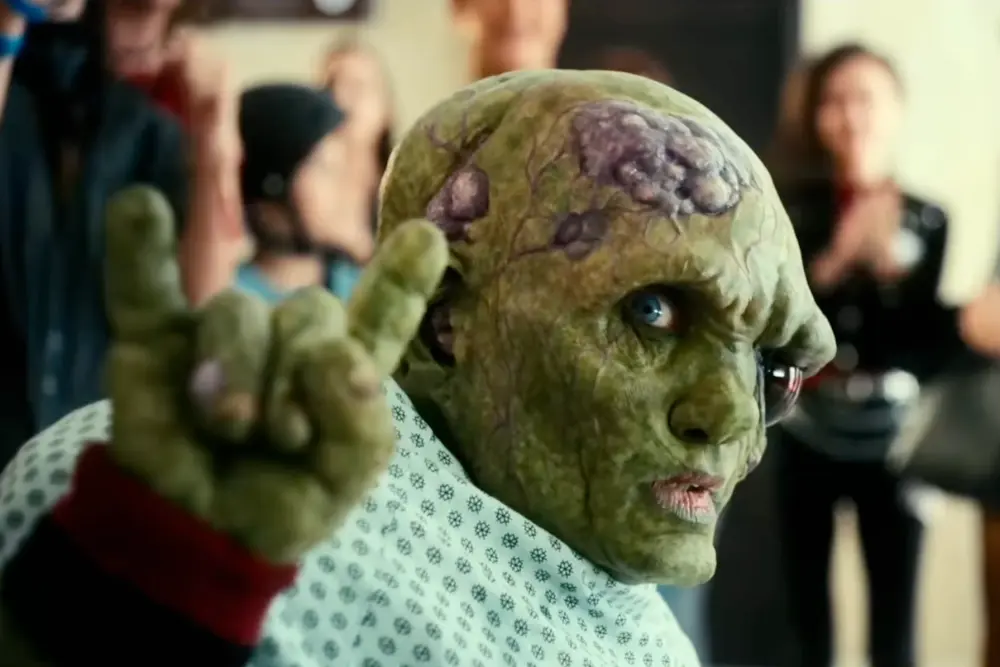
Gore, Practical Effects, and Visual Spectacle
Splatter with Style
The Toxic Avenger gore review must acknowledge that Blair and his effects team have created some of the year’s most memorable kill sequences. Unlike modern horror films that rely heavily on digital effects, The Toxic Avenger unrated film employs primarily practical gore that gives weight and texture to the violence. Each death feels tactile and immediate, recapturing the visceral impact that made the original so memorable.
The film’s “unrated” status becomes immediately apparent in the first major action sequence, where Toxie dispatches a group of criminals with his signature mop in increasingly creative ways. Blair stages these sequences with surprising elegance, finding genuine choreographic beauty in the mayhem while never losing sight of the dark humor that makes it palatable. The violence feels cartoonish enough to be entertaining while maintaining enough genuine impact to feel consequential.
Production designer and effects supervisor work has clearly benefited from the increased budget compared to typical Troma fare. Where the original films often felt genuinely amateur in their technical execution, Blair’s version achieves professional polish without sacrificing the anarchic energy that defined the franchise. The Toxic Avenger suit itself represents a perfect evolution of the original design—recognizably Toxie while feeling like a creature that could actually exist in the real world.
Creative Carnage
The kill sequences themselves demonstrate Blair’s understanding of what made the original work. Rather than simply escalating the gore for its own sake, each death serves the story while showcasing Toxie’s unique approach to vigilante justice. The mop remains his weapon of choice, but Blair finds new ways to employ it that feel fresh while honoring the franchise’s iconography.
The film’s approach to violence walks a difficult tightrope between celebration and critique. While audiences are clearly meant to enjoy Toxie’s brutal dispatching of various corporate criminals and street thugs, Blair ensures that the violence never feels genuinely sadistic or mean-spirited. The targets are uniformly deserving, and Toxie’s childlike innocence prevents the action from becoming genuinely disturbing.
Comparing Old and New: Evolution of an Icon
Honoring the Source
The Toxic Avenger remake succeeds primarily because Blair understands what made the original special without feeling beholden to slavishly recreate every element. The core concept—bullied underdog transformed into unstoppable force for good—remains intact, but Blair updates the execution for contemporary audiences. Where Kaufman’s films often felt genuinely amateur, Blair achieves professional competence while maintaining the subversive spirit.
The environmental messaging that defined the original franchise gets updated for current concerns. While the 1984 version focused on toxic waste as a general environmental threat, the 2025 reboot examines how corporate environmental crimes directly impact working-class communities. Winston’s transformation occurs not through random accident but as a direct result of his employer’s criminal negligence, making the environmental angle feel more politically pointed.
Character development represents perhaps the biggest improvement over the original series. Where Kaufman’s Melvin existed primarily as a plot device, Blair’s Winston feels like a complete human being with understandable motivations and genuine relationships. This character depth doesn’t diminish the anarchic energy—it enhances it by giving audiences genuine emotional investment in the mayhem.
What’s Lost and What’s Gained
Inevitably, some elements of the original’s charm get lost in translation to big-budget filmmaking. The guerrilla filmmaking aesthetic that made Troma films feel genuinely dangerous and unpredictable can’t be perfectly recreated with professional production values. Blair compensates by maintaining narrative unpredictability and tonal complexity that keeps audiences genuinely uncertain about where the story might go.
The increased budget allows for more elaborate set pieces and higher production values, but it also removes some of the original’s DIY punk energy. Where Kaufman’s films felt like genuine outsider art created in opposition to mainstream filmmaking, Blair’s version feels more like a studio film that happens to have transgressive content. This isn’t necessarily a negative—the improved production values make the film more accessible to mainstream audiences—but it does represent a fundamental change in the property’s identity.
Critical Reception and Audience Reaction
Critics Weigh In
The Toxic Avenger movie review aggregated scores reflect the challenging nature of the material. With an 88% critics score on Rotten Tomatoes, the film has earned genuine respect from horror and genre critics while predictably dividing mainstream reviewers. Critics consistently praise Blair’s direction, Dinklage’s committed performance, and the practical effects work while noting that the material’s transgressive nature won’t appeal to all audiences.
The film’s The Toxic Avenger 2023 trailer (released for the film that actually arrived in 2025) generated significant buzz among horror fans while concerning some distributors about commercial viability. Early festival screenings at Fantastic Fest and Beyond Fest earned enthusiastic responses from genre-savvy audiences, but reports of walkouts at general audience screenings suggest the film’s extreme content remains genuinely challenging.
Professional critics have noted Blair’s success in balancing the source material’s requirements with his own directorial voice. Rather than simply imitating Kaufman’s style, Blair creates something that feels authentically his own while remaining recognizably part of the Toxic Avenger franchise. This creative independence has earned critical respect while satisfying longtime fans of the series.
Audience Polarization
Watch The Toxic Avenger screenings have generated passionate responses on both ends of the spectrum. Genre fans and Troma devotees have embraced Blair’s vision as a worthy successor to the original films, praising the improved production values and committed performances. Mainstream audiences, however, have proven less receptive to the film’s uncompromising gore and transgressive humor.
Reports from early UK screenings describe significant audience walkouts, with some theaters losing “at least a third” of their audience before the credits rolled. These reactions suggest the film has succeeded in maintaining the challenging edge that defined the original franchise, even if it limits commercial appeal. For horror fans seeking genuinely subversive content, these walkouts represent a recommendation rather than a warning.
Social media responses have been similarly polarized, with horror communities celebrating the film’s uncompromising vision while general audiences express shock at the extreme content. This division reflects broader cultural conversations about acceptable content in mainstream entertainment and suggests the film has succeeded in pushing boundaries that many contemporary films avoid.
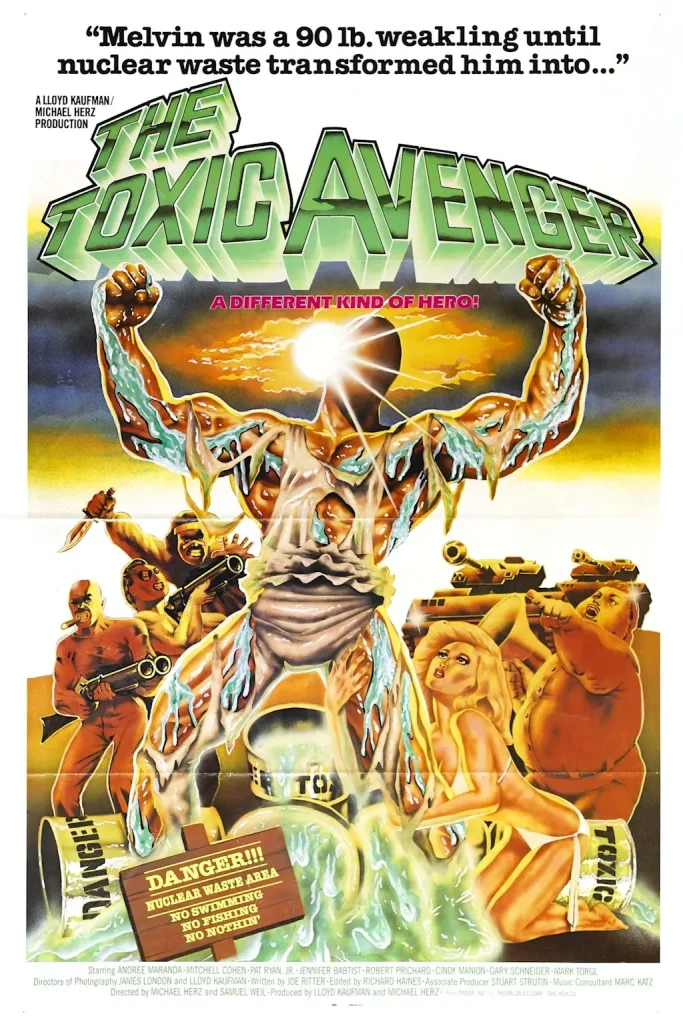
Cultural Impact and Franchise Future
Troma’s Mainstream Moment
The Toxic Avenger 2025 represents Troma Entertainment’s biggest mainstream moment since the original film’s cult success. Lloyd Kaufman and Michael Herz’s involvement as producers ensures continuity with the franchise’s origins while Blair’s direction opens doors to broader audience acceptance. The film’s success could potentially introduce Troma’s aesthetic to a new generation of viewers while validating the company’s decades-long commitment to outsider filmmaking.
The timing coincides with broader cultural conversations about corporate responsibility, environmental justice, and healthcare access that make the film’s themes feel particularly relevant. While the original films’ environmental messaging felt somewhat abstract, the 2025 version’s focus on corporate malfeasance and healthcare denial resonates with contemporary political discussions in ways that make the violence feel more pointed and purposeful.
Independent horror filmmakers have already begun citing the film as proof that challenging content can find mainstream distribution when properly packaged and marketed. The film’s “unrated” theatrical release represents a bold distribution choice that could influence how future horror films approach content restrictions and audience targeting.
Sequel Potential
The film’s ending clearly sets up potential continuation while working as a complete story in its own right. Blair has indicated interest in exploring the Toxic Avenger franchise further if audience response warrants additional films. Given the property’s history of generating sequels (The Toxic Avenger Part II, citizen toxie the toxic avenger iv, etc.), continuation seems likely if the film performs adequately at the box office.
Potential sequels could explore different aspects of the Toxic Avenger mythology while maintaining Blair’s more grounded approach to the material. The film’s corporate corruption angle provides rich territory for social commentary, while the character relationships established here could support deeper exploration in subsequent installments. Blair’s proven ability to balance genre requirements with character development suggests future films could continue evolving the franchise in interesting directions.
The involvement of major actors like Dinklage, Bacon, and Wood also suggests potential for more high-profile casting in future installments. While the original Troma films relied on unknown actors and minimal budgets, Blair’s approach demonstrates that the property can attract serious talent while maintaining its subversive edge.
Technical Excellence Meets Transgressive Art
Direction and Cinematography
Blair’s direction represents the film’s greatest strength, successfully navigating the difficult balance between honoring source material and creating something genuinely fresh. His previous work on “I Don’t Feel at Home in This World Anymore” demonstrated an ability to find humor in violence without glorifying it, skills that prove essential for updating the Toxic Avenger property. Blair stages action sequences with genuine flair while maintaining character focus that prevents the film from becoming simple exploitation.
The cinematography creates a visual language that feels both contemporary and timeless, avoiding the overly stylized approach that might have made the material feel too precious or self-conscious. Instead, Blair and his cinematographer opt for a more naturalistic approach that grounds the fantastic elements in recognizable reality. This choice makes the violence more impactful while ensuring that emotional moments land with genuine weight.
Production design successfully updates the Toxic Avenger aesthetic for contemporary audiences while maintaining visual continuity with the original films. The costume design for Toxie himself represents a perfect evolution of the classic look—immediately recognizable while feeling like a creature that could actually exist in the modern world. Set design creates environments that feel both realistic and slightly heightened, supporting the film’s tonal complexity.
Sound Design and Score
The film’s audio landscape deserves particular recognition for its role in selling both the violence and the humor. Sound effects work makes each impact feel visceral and immediate, crucial for practical effects-heavy action sequences. The sound design team finds the perfect balance between cartoonish exaggeration and realistic impact, ensuring that violence feels consequential without becoming genuinely disturbing.
Musical score supports the narrative without overwhelming it, a crucial consideration for material that already operates at high intensity levels. The composer avoids the obvious choice of purely comedic musical cues, instead creating a soundscape that supports both the film’s emotional moments and its action sequences. This musical restraint allows the performances and practical effects to take center stage while providing appropriate atmospheric support.
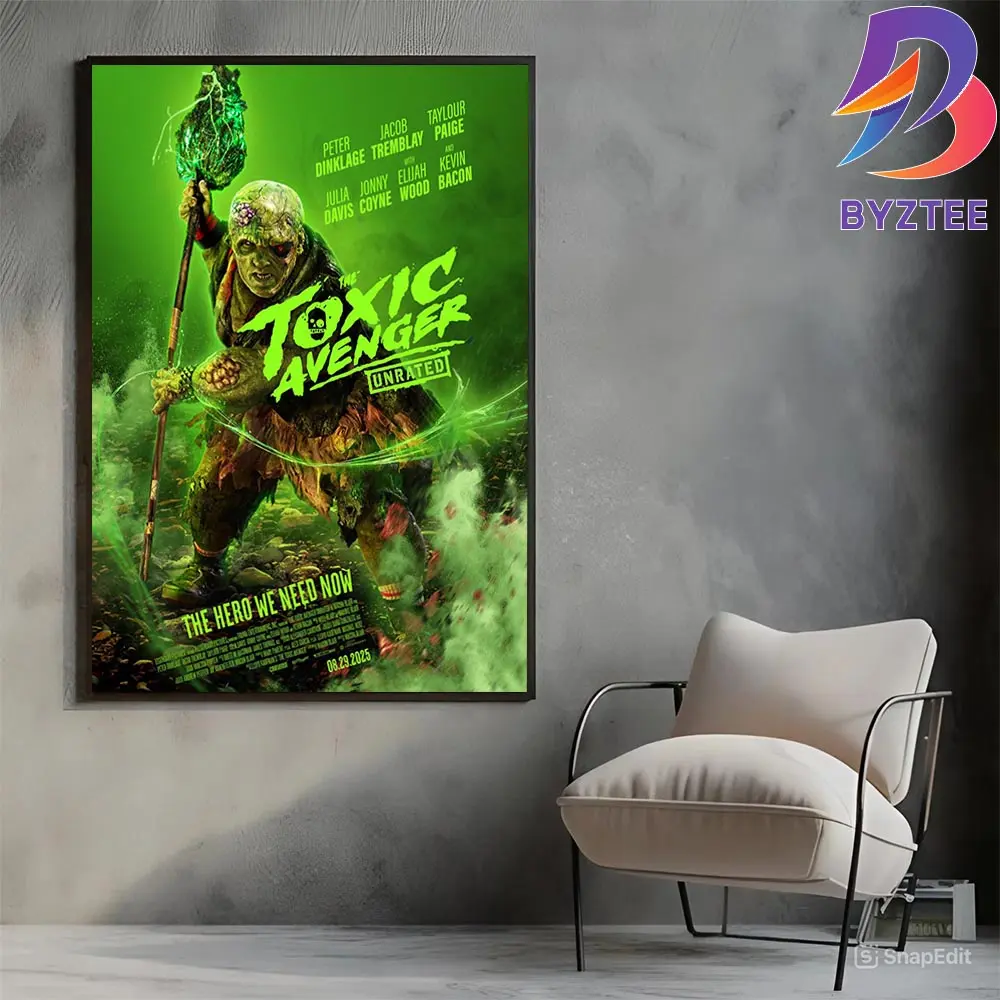
Final Verdict: Toxic Waste or Treasured Trash?
What Works
The Toxic Avenger (2025) succeeds as both loving tribute to the original franchise and standalone entertainment that works for audiences unfamiliar with Troma’s legacy. Blair’s direction skillfully balances multiple tonal requirements while maintaining narrative focus that prevents the film from becoming simple chaos. The cast, led by Dinklage’s committed performance, elevates material that could have easily descended into pure camp.
The practical effects work creates genuinely memorable action sequences that feel both tactile and creative. Unlike many contemporary horror films that rely heavily on digital effects, the primarily practical approach gives weight and texture to the violence that makes each kill feel impactful. The “unrated” content earns its rating through creative carnage rather than simple excess.
Most importantly, the film maintains the subversive spirit that made the original special while updating it for contemporary relevance. The corporate corruption angle feels genuinely pointed in ways that make the violence feel like wish fulfillment rather than simple exploitation. This political edge prevents the film from becoming purely nostalgic exercise while honoring what made the original culturally significant.
Minor Shortcomings
The increased production values, while generally beneficial, do remove some of the guerrilla filmmaking energy that made the original films feel genuinely dangerous and unpredictable. Blair compensates with narrative unpredictability and tonal complexity, but some longtime fans may miss the authentic outsider aesthetic that defined classic Troma productions.
Certain supporting characters could benefit from additional development, though the film’s relatively tight runtime doesn’t leave much space for deeper exploration. Some plot elements feel slightly rushed in service of reaching the action sequences that represent the film’s primary appeal. These structural issues never seriously damage the overall experience but suggest areas where future installments could improve.
The film’s extreme content, while essential to its identity, genuinely limits its potential audience in ways that might impact commercial performance. While horror fans will appreciate the uncompromising approach, mainstream audiences seeking more conventional superhero entertainment will likely be put off by the graphic violence and transgressive humor.
Conclusion: A Triumphant Return to Tromaville
The Toxic Avenger (2025) represents everything a franchise reboot should be: respectful of source material while bringing fresh perspective, technically accomplished while maintaining subversive edge, and entertaining for both newcomers and longtime fans. Blair has created something genuinely special that honors Lloyd Kaufman’s original vision while updating it for contemporary audiences hungry for alternatives to sanitized superhero spectacle.
Peter Dinklage’s committed performance anchors the mayhem in genuine emotion, while Kevin Bacon and the supporting cast embrace the material’s transgressive spirit with obvious enthusiasm. The practical effects work creates visceral impact that modern digital-heavy films often lack, while Blair’s direction maintains perfect tonal balance between comedy and genuine menace.
For horror fans seeking uncompromising content, The Toxic Avenger remake delivers everything promised and more. The film earns its “unrated” status through creative carnage rather than simple excess, while maintaining enough character development and social commentary to justify the extreme content. This isn’t simply exploitation—it’s transgressive art that uses genre elements to examine corporate corruption and environmental justice in ways that feel genuinely relevant.
Whether you’re a longtime Troma devotee or a newcomer curious about the Toxic Avenger franchise, Blair’s reboot offers the perfect entry point into this uniquely twisted universe. Just be prepared for genuinely challenging content that pushes boundaries most contemporary films avoid—exactly what the best horror cinema should do.
Final Rating: ★★★★☆
The hero New Jersey needs has returned, and he’s exactly as gloriously demented as fans hoped he would be.
